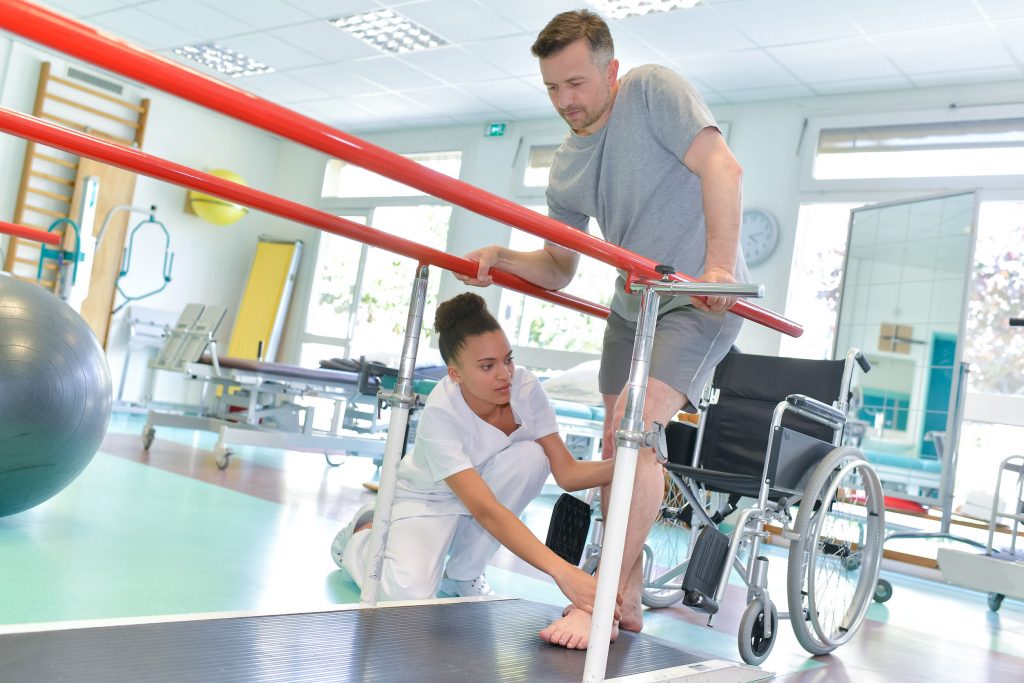Node Smith, ND
Two recent articles have shown the possible to be possible, paralytic individuals regaining the ability to walk.1,2 Doctors from Switzerland have had initial success and continued progress with using electrical implants along the spinal column to enable 3 paralyzed men to walk again after life in a wheelchair.
Electrical implants placed along the spinal cord intended to perpetuate signals sent along the cord to lower extremities
The electrical implants are placed along the spinal cord and are intended to perpetuate signals sent along the cord to the lower extremities. The devices were implanted at the base of the spine. In addition, the stimulation seemed to actually help damaged nerves to regrow and restore some function, something which runs contrary to the current understanding of nerve injuries.
Breakthrough research could mean that individuals previously bound to wheelchairs may have the opportunity to walk again
This breakthrough research could literally mean that individuals who have been previously bound to wheelchairs may have the opportunity to walk again. The results from the experimental case studies have been published in Nature as well as a follow up article in Nature Neuroscience.
First patient was a 30-year-old Swiss man
The first patient was a 30-year-old Swiss man, David M’zee. After a sports injury caused severe spinal damage 7 years ago, he’s been confined to a wheelchair ever since; paralyzed from the waist down. The experimental implantation was led by Dr Grégoire Courtine. an electrical spinal implant developed by a team at École Polytechnique Fédérale de Lausanne (EPFL) was inserted at the base of his spine. Dr Jocelyne Bloch, from Lausanne University Hospital, performed the surgery.
Not only was function regained to some extent, but also the nerves were seen to be regrowing
While the implant is switched on, Mr. M’zee can walk for roughly 1 kilometer, or about half a mile. The doctors were surprised to note that not only was function regained to some extent, but also the nerves were seen to be regrowing. “When you stimulate the nerves like this it triggers plasticity in the cells. The brain is trying to stimulate, and we stimulate at same time, and we think that triggers the growth of new nerve connections,” said Courtine.
Mr. M’zee can still walk about 8 steps after implant is turned off
After the implant is turned off, Mr. M’zee can still walk about 8 steps, which is incredible improvement for someone who was recently paralyzed from the waist down.
Two other men, ages 35 and 48, have successfully walked after this implant was inserted
Two other men have successfully walked after having this electrical implant surgically inserted. Gertan Oskan, a 35-year old man who was paralyzed after a severe auto accident 7 years previously, and Sebastian Tobler, a 48-year old German who had been paralyzed during a cycling accident. All 3 men had been told they would never walk again, and were at the time of the treatment.
Author states, “it now appears that many people can regain the ability to control their paralyzed limbs and even walk again through the innovative combination of spinal stimulation and rehabilitation”
Chet Moritz at the University of Washington in Seattle wrote an accompanying article saying, “it now appears that many people can regain the ability to control their paralyzed limbs and even walk again through the innovative combination of spinal stimulation and rehabilitation … This stimulation combined with rehabilitation is actually helping to direct plasticity and healing of the nervous system around the injury.”
The implant cannot be kept on permanently, because it can become uncomfortable over time. In addition, the movement that the patients have experienced has been in controlled physical therapy environments.
Paralysis might be completely avoided if devices such as this could be used closer to the time of an accident
The current thought is that if devices such as this could be used closer to the time of an accident resulting in spinal cord injury, that paralysis might be completely avoided.
Chet Moritz added in the accompanying article, “we should consider these results across 3 independent research groups as a breakthrough in the treatment of paralysis. The field of spinal cord injury is poised to take a giant leap forward in the treatment of what was until very recently considered incurable: paralysis.”
Team plans on conducting larger trials within next 3 years
The team is planning to conduct larger trials across Europe and United States within the next 3 years.
Sources:
 Node Smith, ND, is a naturopathic physician in Portland, OR and associate editor for NDNR. He has been instrumental in maintaining a firm connection to the philosophy and heritage of naturopathic medicine among the next generation of docs. He helped found the first multi-generational experiential retreat, which brings elders, alumni, and students together for a weekend camp-out where naturopathic medicine and medical philosophy are experienced in nature. Four years ago he helped found the non-profit, Association for Naturopathic ReVitalization (ANR), for which he serves as the board chairman. ANR has a mission to inspire health practitioners to embody the naturopathic principles through experiential education. Node also has a firm belief that the next era of naturopathic medicine will see a resurgence of in-patient facilities which use fasting, earthing, hydrotherapy and homeopathy to bring people back from chronic diseases of modern living; he is involved in numerous conversations and projects to bring about this vision.
Node Smith, ND, is a naturopathic physician in Portland, OR and associate editor for NDNR. He has been instrumental in maintaining a firm connection to the philosophy and heritage of naturopathic medicine among the next generation of docs. He helped found the first multi-generational experiential retreat, which brings elders, alumni, and students together for a weekend camp-out where naturopathic medicine and medical philosophy are experienced in nature. Four years ago he helped found the non-profit, Association for Naturopathic ReVitalization (ANR), for which he serves as the board chairman. ANR has a mission to inspire health practitioners to embody the naturopathic principles through experiential education. Node also has a firm belief that the next era of naturopathic medicine will see a resurgence of in-patient facilities which use fasting, earthing, hydrotherapy and homeopathy to bring people back from chronic diseases of modern living; he is involved in numerous conversations and projects to bring about this vision.





